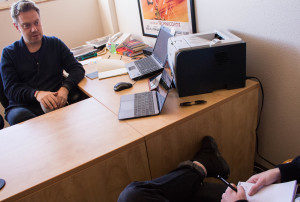Tags
Related Posts
Share This
SFU Press
The Creative Writing and Literature Department at SFUAD is rolling out an exciting and unique new project for students and alumni: The Santa Fe University Press.
Department Chairman James Reich says the first goal of the press as giving Glyph, the annual in-house collection of student works, a “higher profile” by making it into a commercially available literary collection. In fact, the 2016 edition of Glyph will be the press’ debut, allowing the collection to be purchased on Amazon or ordered directly by booksellers and libraries. He says he, “wants this wonderful in-house journal to get its national and international standing.” After Glyph, the next publication is a fall anthology titled, Chimera. Chimera will be a collection of fiction in commemoration of the 200th anniversary of Mary Shelley’s classic horror, Frankenstein.
Beyond that, Reich—who began his term as chair this semester—hopes to have the press publishing two books a year: Glyph in the spring and a collection of fiction, poetry or nonfiction, in the fall. He also hopes to offer book-deals with the press as rewards and prizes to exemplary students.
Regarding the day-to-day operations of the press, Reich says “what we envisage is to offer intern positions to undergrads,” he says, “and that the writing, editing and design is done primarily by students.” The press would provide an opportunity that he describes as “unusual” and “unique”, given most university presses are dryly academic, only offering opportunities to postgraduate students. Santa Fe University Press, on the other hand, would provide students with a hands-on understanding of the way a small press functions, and the ability to publish more popular creative works of their own and of their peers. In an age where starting a small press of one’s own is a reality, this is incredibly valuable. “The experience of [the CWL faculty] showing students how a small press can be developed is excellent,” Reich says. These skills, he describes, would create a system of, “better credits going out and better experience coming in.”
When asked if this was his brainchild, he was careful to give credit to other faculty saying, “It has been on the table for a while now. Both Julia [Goldberg] and I have had conversations about it.” He describes the chair position as allowing him more space to take the reigns and coordinate this venture and that he was driven by, “a responsibility to bring something new and different to the Creative Writing Department.” The press seems like just that.
“It’s just a shift,” Reich says in closing. “We’ve always produced books, but why not produce books that reflect the professional nature of our students.”







 Jackalope Magazine is the student magazine of Santa Fe University of Art and Design. Building on the interdisciplinary nature of our education, we aim to showcase the talent of our university and character of our city.
Jackalope Magazine is the student magazine of Santa Fe University of Art and Design. Building on the interdisciplinary nature of our education, we aim to showcase the talent of our university and character of our city.
0 Comments
Trackbacks/Pingbacks